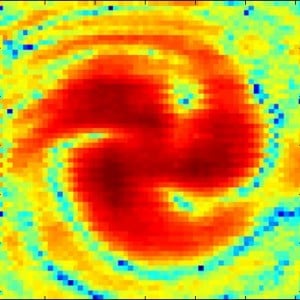This article is more than 1 year old
US boffins demo 'twisted radio' mux
OAM takes wireless signals to 32 Gbps
Evidence continues to mount that the orbital angular momentum (OAM) of radio waves – “twisted waves” – can be exploited to modulate multiple data streams on the same spatial path.
Researchers from the University of Southern California are claiming an impressive 32 Gbps transmission, albeit over a distance of 2.5 metres, using eight OAM channels – four independent OAM beams on each of two polarisations.
In a paper to be published in Nature Communications, a group led by Alan Willner claims a spectral efficiency of 16 bits/second/Hz on a 28 GHz carrier. Willner earlier led research that twisted photons to multiplex two ten-wavelength signals on the same 1.1 Km length of fibre for a 1.6 Tbps transmission.
In the current demonstration, described in this USC release, the same principles are applied to free-space communications in millimetre-wave radio signals (which are, after all, photons with longer wavelengths than light).
A “spiral phase plate” – similar to the antenna used in the controversial experiments by Swedish professor Bo Thide in 2012 – is used to apply the twist to the signals, and to demodulate the spin at the other end.

Twisted radio wave intensity plot
Image: Alan Willner, USC Viterbi
While 32 Gbps is an impressive throughput for a radio transmission, the USC group isn't repeating the “infinite bandwidth” hype that accompanied Thide's original announcement. The USC paper notes that the number of OAM beams a system can support is limited by various factors, like the receiver aperture size, crosstalk between beams, and the phase difference between different OAM channels.
In a nod towards the earlier controversies that have surrounded OAM – a criticism in 2012 was that what Bo Thide and Fabrizio Tamburini observed was actually a MIMO path created by the spiral antenna – the USC group note: “In our implementation, the multiplexed beams are completely coaxial throughout the transmission medium and use only one transmitter and receiver aperture”, whereas MIMO schemes demand multiple transmit and receive antennas.
DARPA and Intel supported the research, and the study's co-lead authors are Yan Yan and Guodong Xie of USC Viterbi, with contributions from the University of Glasgow and Tel Aviv University. ®
